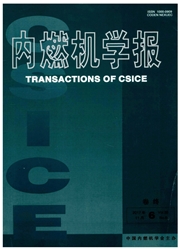

 中文摘要:
中文摘要:
用数值模拟的方法研究了柴油机稀燃NOx捕集技术(LNT)浓燃再生过程中CO还原NO的反应过程.建立了铂(Pt)催化剂表面CO还原NO的详细化学反应机理模型,该机理包括5种气相组分、5种表面组分和11步基元反应,其中包含了CO2、N2和副产物N2O的生成路径.对反应器出口各主要组分摩尔分数随温度的变化情况进行了模拟,其结果与文献中的试验数据吻合良好.CO和NO的反应开始于250,℃左右,N2O为低温区间的主要产物;300,℃时,N2开始生成,并逐渐取代N2O成为主要产物.分析了生成N2的两条反应路径,结果表明:当温度低于330,℃时,N原子重组路径占主导;而温度高于330,℃时,N2O分解路径占主导.此外,预测了CO摩尔分数对CO和NO转化率的影响,证明了CO自抑制效应,即随着CO摩尔分数的增加NO转化率先升高后降低.
 英文摘要:
英文摘要:
NO reduction by CO during regeneration period of diesel lean NOx trap (LNT) was studied with numerical simulation method. A detailed mechanism for CO-NO reaction over Pt catalyst, consisting of 5 gas phase species, 5 surface species and 11 elementary reaction steps, was proposed. The mechanism includes the routes for the formation of CO2, N2 and by-product N2O. The predicted temperature dependences of the concentrations of main products are in good agreement with experimental results. Reaction of CO-NO starts from 250 ℃ and N2O is main product at low temperature range. However, when temperature reaches 300 ℃, N2 starts to generate and becomes the main product. Two routes of N2 formation were clarified. Results show that the recombination of two adsorbed N atoms is dominant at the temperatures below 330 ℃, while N2O decomposition dominates at the temperatures higher than 330 ℃. Additionally, the impact of CO concentration on the conversion of CO and NO was predicted and self-inhibition effect of CO was proved. With increasing CO mole fraction, conversion of NO increases firstly and decreases thereafter.
 同期刊论文项目
同期刊论文项目
 同项目期刊论文
同项目期刊论文
 期刊信息
期刊信息
